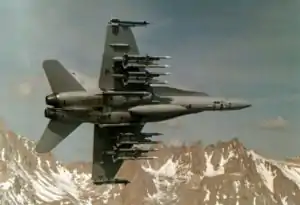LAU-127
The LAU-127 is a missile rail launcher (MRL) manufactured by Marvin Engineering Co., Inc., based in Inglewood, California.[3][4]
| LAU-127 | |
|---|---|
 LAU-127 missile launchers mounted on a US Navy F/A-18C Hornet | |
| Type | Missile Rail Launcher |
| Place of origin | United States |
| Service history | |
| Used by | United States Navy Kuwait Air Force Swiss Air Force[1] |
| Production history | |
| Manufacturer | Marvin Engineering Co., Inc |
| Unit cost | $65,000 for LAU-127E/A variant[2] |
| Variants | LAU-127A/A, LAU-127B/A, LAU-127C/A, LAU-127D/A, LAU-127E/A, and LAU-127F/A LAU-139 |
| Specifications | |
| Mass | 87 lb (39 kg) to 95 lb (43 kg)[3] |
| Length | 106 in (2.7 m)[3] |
| Width | 3.62 in (9.2 cm)[3] |
| Height | 6.06 in (15.4 cm)[3] |
The Marvin LAU-127 enables the McDonnell Douglas F/A-18 Hornet multirole combat aircraft to carry and launch the AIM-120 Advanced Medium-Range Air-to-Air Missile, or AMRAAM, as well as the AIM-9L, M, and X variants of the AIM-9 Sidewinder missile. The launcher also provides the mechanical and electrical interface between the missile systems and the F/A-18 aircraft, as well as enabling the two-way data communications between the weapon and the aircraft's cockpit controls and displays.[1]
The LAU-127 fires a missile from weapon stations under the wing of the aircraft, mounted to pylons, or on wingtip hard points.[1] When configured on the wing tips, LAU-127 attaches directly to the aircraft wing, as seen on the empty leftmost wingtip station in the picture of the F/A-18E, to launch a variant of the AIM-9 missile. When configured under the wings to fire the AIM-120, LAU-127 attaches to a Raytheon LAU-115C/A guided missile rail launcher, which in turn is suspended from a Marvin BRU-32 bomb ejection rack that is attached to one of two SUU-79/SUU-80 pylon stations underneath each aircraft wings.[5][6]
The LAU-127 can be integrated with McDonnell Douglas F/A-18A/B/C/D variants of the Hornet, the Boeing F/A-18E/F Super Hornet, and the Boeing EA-18G Growler. The launcher features a power supply and bottled nitrogen or a self-contained compressor, such as a HiPPAG, for missile seeker cooling. The weights vary slightly among the different variants (LAU-127A/A to LAU-127F/A), and the LAU-127C/A HiPPAG units equipped with Pure Air Generating System (PAGS) are also slightly longer than the versions equipped with nitrogen bottles (LAU-127A/A, B/A, and E/A).[1][4] The units with nitrogen bottles contain a ADU-729/E Nitrogen Receiver Adapter to hold the bottles.[7]
The LAU-139 for the Saab JAS 39 Gripen is also a variation of the LAU-127 Launcher.[4]
For United States Navy and United States Marine Corps aviation, the Naval Air Systems Command is responsible for Research, Development, and Acquisition (RDA) activities. Specifically, the Program Executive Office, Unmanned Aviation and Strike Weapons (PEO(U&W)),[8] which reports to the Assistant Secretary of the Navy (Research, Development and Acquisition), oversees Program PMA-201 for Precision Strike Weapons,[9] which includes RDA activities for aircraft armament equipment, including missile launchers.[2][10]
See also
Footnotes
- "Marvin to provide 770 sidewinder and AMRAAM air-to-air missile launchers for Navy F/A-18 combat jet". Military&Aerospace Electronics. 20 September 2019. Retrieved 7 November 2020.
- "Department of Defense Fiscal Year (FY) 2021 Budget Estimates" (pdf). Department of the Navy. February 2020. p. 132. Retrieved 7 November 2020.
- "LAU-127 MRL" (PDF). Marvin Engineering Co., Inc. Retrieved 7 November 2020.
- "LAU-127 For F/A-18A-F Hornet/Super Hornet". Marvin Engineering Co., Inc. Retrieved 7 November 2020.
- "LAU-115/A and LAU-115A/A Guided Missile Launchers". globalsecurity.org. Retrieved 8 November 2020.
- "Chapter 15 - Aircraft Weapon Systems" (PDF). NRTC. pp. 15–20. Retrieved 9 November 2020.
- "Chapter 9 - Ammunition Handling Equipment" (PDF). NRTC. pp. 9–18. Retrieved 9 November 2020.
- "Program Executive Office, Unmanned and Weapons". Naval Air Systems Command. Retrieved 7 November 2020.
- "Precision Strike Weapons Program". Naval Air Systems Command. Retrieved 7 November 2020.
- "AAE/FC". Naval Air Systems Command. Retrieved 7 November 2020.